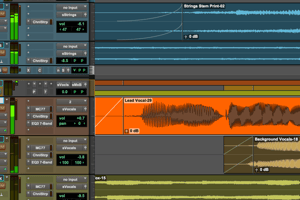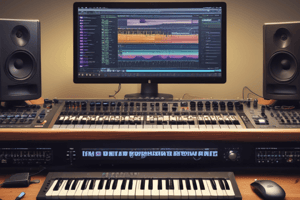Podcast
Questions and Answers
What does the 'Clip by Clip' option do when selected?
What does the 'Clip by Clip' option do when selected?
- Individually analyzes each selected clip. (correct)
- Reverses the sound of each clip.
- Processes clips in real time.
- Analyzes all clips simultaneously.
The Reverse AudioSuite plug-in allows actions to be performed in real time.
The Reverse AudioSuite plug-in allows actions to be performed in real time.
False (B)
List the first step in the traditional workflow to create a reverse reverb effect.
List the first step in the traditional workflow to create a reverse reverb effect.
Select a clip that you want to process.
Clicking the Reverse button in an AudioSuite plug-in applies reverb or delay and then ______ it again.
Clicking the Reverse button in an AudioSuite plug-in applies reverb or delay and then ______ it again.
Match the terms with their descriptions related to AudioSuite plug-ins:
Match the terms with their descriptions related to AudioSuite plug-ins:
What is the primary purpose of an insert in a mixing desk?
What is the primary purpose of an insert in a mixing desk?
Inserts are specifically required for adding effects in a track's signal chain.
Inserts are specifically required for adding effects in a track's signal chain.
What is meant by the term 'insert return'?
What is meant by the term 'insert return'?
The signal chain might go something like Input > EQ > Inserted ______ > Fader > Pan > Output.
The signal chain might go something like Input > EQ > Inserted ______ > Fader > Pan > Output.
Which of the following is NOT a goal described in this lesson?
Which of the following is NOT a goal described in this lesson?
What does the term 'insert send' refer to?
What does the term 'insert send' refer to?
Match the terms related to inserts with their definitions:
Match the terms related to inserts with their definitions:
Which statement best describes the effect of the order of connections in the insert structure?
Which statement best describes the effect of the order of connections in the insert structure?
What is the first step in instantiating a plug-in on an insert in Pro Tools?
What is the first step in instantiating a plug-in on an insert in Pro Tools?
A bypassed plug-in will still draw upon your computer's processing power.
A bypassed plug-in will still draw upon your computer's processing power.
What key must be held down to copy a plug-in while dragging it?
What key must be held down to copy a plug-in while dragging it?
To remove an insert, select the insert selector and choose ______.
To remove an insert, select the insert selector and choose ______.
Match the action to its corresponding description:
Match the action to its corresponding description:
Which plug-in category is mentioned as an example in the process of instantiation?
Which plug-in category is mentioned as an example in the process of instantiation?
Plug-ins on Audio/Aux/Instrument tracks are processed post-fader.
Plug-ins on Audio/Aux/Instrument tracks are processed post-fader.
How can a user bypass a plug-in using the keyboard?
How can a user bypass a plug-in using the keyboard?
What is the primary function of a Master Fader track?
What is the primary function of a Master Fader track?
When deactivating a plug-in, the insert assignment will appear ______ with the name of the plug-in in italic font.
When deactivating a plug-in, the insert assignment will appear ______ with the name of the plug-in in italic font.
A limiter is a type of compressor plug-in used to prevent signals from exceeding a preset level.
A limiter is a type of compressor plug-in used to prevent signals from exceeding a preset level.
Which of the following allows you to temporarily hear the unprocessed original sound?
Which of the following allows you to temporarily hear the unprocessed original sound?
What are the three major types of plug-in formats mentioned?
What are the three major types of plug-in formats mentioned?
You can drag a plug-in from one track's insert to another track's insert.
You can drag a plug-in from one track's insert to another track's insert.
The __________ is a small button that indicates the position of the insert on a track.
The __________ is a small button that indicates the position of the insert on a track.
What visual indication shows that a plug-in is bypassed?
What visual indication shows that a plug-in is bypassed?
Match the following plug-in formats with their descriptions:
Match the following plug-in formats with their descriptions:
Inserts are processed in a series from insert A through insert ______.
Inserts are processed in a series from insert A through insert ______.
Which of the following statements about AU plug-ins is true?
Which of the following statements about AU plug-ins is true?
What happens to a deactivated insert in terms of computer resources?
What happens to a deactivated insert in terms of computer resources?
The Plug-In Selector allows users to quickly change between different effects without closing the plug-in window.
The Plug-In Selector allows users to quickly change between different effects without closing the plug-in window.
What does the Track Selector do in the plug-in window?
What does the Track Selector do in the plug-in window?
A plug-in is a bit of __________ code that adds functionality to a program.
A plug-in is a bit of __________ code that adds functionality to a program.
Match the following plug-in controls with their purposes:
Match the following plug-in controls with their purposes:
What must be set up to use external hardware effects in a mix?
What must be set up to use external hardware effects in a mix?
VST plug-ins are preferred by many freeware developers for virtual instruments.
VST plug-ins are preferred by many freeware developers for virtual instruments.
What is the purpose of the Folder Selector in the plug-in settings?
What is the purpose of the Folder Selector in the plug-in settings?
AAX plug-ins have the capability to report their __________ to Pro Tools for accurate processing.
AAX plug-ins have the capability to report their __________ to Pro Tools for accurate processing.
What does the Compare button do in the plug-in window?
What does the Compare button do in the plug-in window?
The Bypass button indicates that a plug-in is being processed by DSP chips.
The Bypass button indicates that a plug-in is being processed by DSP chips.
What is the function of the Insert selector in a multichannel track?
What is the function of the Insert selector in a multichannel track?
A _____ plug-in processes multiple audio streams within a single plug-in window.
A _____ plug-in processes multiple audio streams within a single plug-in window.
Match the following plug-in types with their characteristics:
Match the following plug-in types with their characteristics:
What happens when the Master Link button is active?
What happens when the Master Link button is active?
When using sends, the original signal is blended with the effected signal.
When using sends, the original signal is blended with the effected signal.
What do you need to do to relink a multi-mono plug-in?
What do you need to do to relink a multi-mono plug-in?
In Pro Tools, a plug-in that is processed by the CPU is indicated as _____ plug-in.
In Pro Tools, a plug-in that is processed by the CPU is indicated as _____ plug-in.
Which effect is NOT classified as a dynamic effect?
Which effect is NOT classified as a dynamic effect?
All plug-ins are available as multichannel and mono plug-ins.
All plug-ins are available as multichannel and mono plug-ins.
What is the primary purpose of using EQ in mixing?
What is the primary purpose of using EQ in mixing?
The _____ button in a plug-in window allows toggling effects on or off.
The _____ button in a plug-in window allows toggling effects on or off.
Match the following effects with their functions:
Match the following effects with their functions:
What is the primary function of a send in a mixing context?
What is the primary function of a send in a mixing context?
The output of a send is directly mixed with the original signal in an analog console.
The output of a send is directly mixed with the original signal in an analog console.
What equipment is necessary to add reverb to vocals using an analog console?
What equipment is necessary to add reverb to vocals using an analog console?
In this setup, the output of the reverb is routed to available __________ on the mixing board.
In this setup, the output of the reverb is routed to available __________ on the mixing board.
Match the following components with their functions:
Match the following components with their functions:
What is the advantage of using a single reverb plug-in for multiple tracks?
What is the advantage of using a single reverb plug-in for multiple tracks?
Using individual reverb effects on each track is more processing efficient than using a single reverb plug-in.
Using individual reverb effects on each track is more processing efficient than using a single reverb plug-in.
Why is realism an advantage of using send/return setups in mixing?
Why is realism an advantage of using send/return setups in mixing?
The faders on the return tracks function as a master control over the amount of __________ in the mix.
The faders on the return tracks function as a master control over the amount of __________ in the mix.
Match the mixing window elements with their functions:
Match the mixing window elements with their functions:
What type of effects are traditionally routed using send/return setups?
What type of effects are traditionally routed using send/return setups?
In Pro Tools, you can not use busses for setting up sends.
In Pro Tools, you can not use busses for setting up sends.
What visual elements can be shown or hidden in the Edit or Mix window in Pro Tools?
What visual elements can be shown or hidden in the Edit or Mix window in Pro Tools?
To apply reverb to multiple vocal tracks, you need to create identical sends assigned to the same __________.
To apply reverb to multiple vocal tracks, you need to create identical sends assigned to the same __________.
Match the processes of creating sends in Pro Tools:
Match the processes of creating sends in Pro Tools:
What is the primary purpose of a cue mix?
What is the primary purpose of a cue mix?
AudioSuite plug-ins can be automated within the Pro Tools project.
AudioSuite plug-ins can be automated within the Pro Tools project.
What does the Render button do in the AudioSuite window?
What does the Render button do in the AudioSuite window?
The plug-ins that process audio in real time are called ________ effects.
The plug-ins that process audio in real time are called ________ effects.
Match the AudioSuite processing modes to their descriptions:
Match the AudioSuite processing modes to their descriptions:
What action can you take using the Preview button in the AudioSuite plug-in?
What action can you take using the Preview button in the AudioSuite plug-in?
The AudioSuite window allows changing effects without closing the window.
The AudioSuite window allows changing effects without closing the window.
What is the purpose of the Selection Reference Selector in the AudioSuite window?
What is the purpose of the Selection Reference Selector in the AudioSuite window?
AudioSuite plug-ins are ________ based, meaning they process files directly.
AudioSuite plug-ins are ________ based, meaning they process files directly.
In which mode does the AudioSuite plug-in create a new audio file for each selected clip?
In which mode does the AudioSuite plug-in create a new audio file for each selected clip?
The USE IN PLAYLIST button determines whether the processed clip will be used on your track.
The USE IN PLAYLIST button determines whether the processed clip will be used on your track.
What happens to the audio clip's name after applying an AudioSuite effect?
What happens to the audio clip's name after applying an AudioSuite effect?
The term ________ refers to a customized blend of tracks for musicians to hear.
The term ________ refers to a customized blend of tracks for musicians to hear.
Match the AudioSuite plug-in features with their functions:
Match the AudioSuite plug-in features with their functions:
What is the purpose of creating a stereo Aux track named 'Verb'?
What is the purpose of creating a stereo Aux track named 'Verb'?
It is necessary to manually solo-safe the reverb Aux track in Pro Tools.
It is necessary to manually solo-safe the reverb Aux track in Pro Tools.
What is the function of the Send window in Pro Tools?
What is the function of the Send window in Pro Tools?
The original audio tracks are the __________ part of the mix, and the Aux track is the __________ part.
The original audio tracks are the __________ part of the mix, and the Aux track is the __________ part.
Match the following terms with their definitions:
Match the following terms with their definitions:
What happens when the PRE button is highlighted in the Send window?
What happens when the PRE button is highlighted in the Send window?
Sends can be moved from one track to another by dragging them.
Sends can be moved from one track to another by dragging them.
What shortcut can be used to set a send's level to unity?
What shortcut can be used to set a send's level to unity?
In Pro Tools, a send typically starts as a __________ send.
In Pro Tools, a send typically starts as a __________ send.
When you create a send for an Aux track, what happens to the output if the send is set to pre-fader?
When you create a send for an Aux track, what happens to the output if the send is set to pre-fader?
The output of the reverb return is typically routed to the subgroup master Aux track.
The output of the reverb return is typically routed to the subgroup master Aux track.
What should be done to the input of the Aux track to complete the signal routing process?
What should be done to the input of the Aux track to complete the signal routing process?
You can open multiple Send windows by holding the __________ key while clicking on Send Assignment buttons.
You can open multiple Send windows by holding the __________ key while clicking on Send Assignment buttons.
Which key combination is used to copy a send from one track to another?
Which key combination is used to copy a send from one track to another?
In the Send window, clicking 'no send' will remove the selected send.
In the Send window, clicking 'no send' will remove the selected send.
Flashcards
Insert
Insert
A point in a signal chain where external processing units can be added.
Virtual Insert
Virtual Insert
A virtual representation of a physical insert on a mixing desk. It allows users to add effects to a track's signal path.
Signal Chain Order
Signal Chain Order
The order in which effects are applied to a signal. Effects applied earlier in the chain will influence the signal before later effects.
Insert Effects
Insert Effects
Signup and view all the flashcards
Effect Send
Effect Send
Signup and view all the flashcards
Effect Return
Effect Return
Signup and view all the flashcards
Send/Return Effects
Send/Return Effects
Signup and view all the flashcards
AudioSuite Processing
AudioSuite Processing
Signup and view all the flashcards
Instantiating a plugin
Instantiating a plugin
Signup and view all the flashcards
Re-ordering plug-ins
Re-ordering plug-ins
Signup and view all the flashcards
Bypassing a plug-in
Bypassing a plug-in
Signup and view all the flashcards
Deactivating a plug-in
Deactivating a plug-in
Signup and view all the flashcards
Removing a plug-in
Removing a plug-in
Signup and view all the flashcards
Pre-fader insert
Pre-fader insert
Signup and view all the flashcards
Post-fader insert
Post-fader insert
Signup and view all the flashcards
Dynamic effects plug-ins
Dynamic effects plug-ins
Signup and view all the flashcards
Compressor
Compressor
Signup and view all the flashcards
Expander
Expander
Signup and view all the flashcards
Volume fader
Volume fader
Signup and view all the flashcards
Sonic qualities
Sonic qualities
Signup and view all the flashcards
Dynamic range
Dynamic range
Signup and view all the flashcards
Adding punch and power to a mix
Adding punch and power to a mix
Signup and view all the flashcards
Limiter
Limiter
Signup and view all the flashcards
Plug-ins
Plug-ins
Signup and view all the flashcards
VST
VST
Signup and view all the flashcards
AU
AU
Signup and view all the flashcards
AAX
AAX
Signup and view all the flashcards
Track Selector
Track Selector
Signup and view all the flashcards
Insert Position Selector
Insert Position Selector
Signup and view all the flashcards
Plug-in Selector
Plug-in Selector
Signup and view all the flashcards
Presets
Presets
Signup and view all the flashcards
Librarian Menu
Librarian Menu
Signup and view all the flashcards
Increment Setting Every [#] Seconds
Increment Setting Every [#] Seconds
Signup and view all the flashcards
Plug-In Settings Select
Plug-In Settings Select
Signup and view all the flashcards
Folder Selector
Folder Selector
Signup and view all the flashcards
Plugging In
Plugging In
Signup and view all the flashcards
Latency
Latency
Signup and view all the flashcards
Compare Button
Compare Button
Signup and view all the flashcards
Plug-in Settings Menu
Plug-in Settings Menu
Signup and view all the flashcards
Multichannel Plug-in
Multichannel Plug-in
Signup and view all the flashcards
Multi-Mono Plug-in
Multi-Mono Plug-in
Signup and view all the flashcards
Master Link Button
Master Link Button
Signup and view all the flashcards
Channel Selector
Channel Selector
Signup and view all the flashcards
Relink Dialog Box
Relink Dialog Box
Signup and view all the flashcards
Dynamic Effects
Dynamic Effects
Signup and view all the flashcards
Reverbs
Reverbs
Signup and view all the flashcards
Delays
Delays
Signup and view all the flashcards
EQ (Equalization)
EQ (Equalization)
Signup and view all the flashcards
Reverse AudioSuite Plug-in
Reverse AudioSuite Plug-in
Signup and view all the flashcards
Reverse Reverb
Reverse Reverb
Signup and view all the flashcards
Reverse Button in AudioSuite Plug-ins
Reverse Button in AudioSuite Plug-ins
Signup and view all the flashcards
Signal Chain Order in Pro Tools
Signal Chain Order in Pro Tools
Signup and view all the flashcards
Effect Return Aux Track
Effect Return Aux Track
Signup and view all the flashcards
Subgroup Aux Track
Subgroup Aux Track
Signup and view all the flashcards
Send
Send
Signup and view all the flashcards
Send Level
Send Level
Signup and view all the flashcards
Pre-Fader Send
Pre-Fader Send
Signup and view all the flashcards
Post-Fader Send
Post-Fader Send
Signup and view all the flashcards
Dry Signal
Dry Signal
Signup and view all the flashcards
Wet Signal
Wet Signal
Signup and view all the flashcards
Wet/Dry Mix
Wet/Dry Mix
Signup and view all the flashcards
Multi-Track Routing
Multi-Track Routing
Signup and view all the flashcards
Adjusting Send Parameters
Adjusting Send Parameters
Signup and view all the flashcards
Send Window
Send Window
Signup and view all the flashcards
Send Selector
Send Selector
Signup and view all the flashcards
Send/Return Routing
Send/Return Routing
Signup and view all the flashcards
Return
Return
Signup and view all the flashcards
Time-Based Effects
Time-Based Effects
Signup and view all the flashcards
Parallel Processing
Parallel Processing
Signup and view all the flashcards
DAW (Digital Audio Workstation)
DAW (Digital Audio Workstation)
Signup and view all the flashcards
Effect Level Control
Effect Level Control
Signup and view all the flashcards
Waveform Display
Waveform Display
Signup and view all the flashcards
Effect Settings Adjustment
Effect Settings Adjustment
Signup and view all the flashcards
What is AudioSuite processing?
What is AudioSuite processing?
Signup and view all the flashcards
What is a real-time effect?
What is a real-time effect?
Signup and view all the flashcards
What is the preview feature in AudioSuite?
What is the preview feature in AudioSuite?
Signup and view all the flashcards
Can AudioSuite effects be automated?
Can AudioSuite effects be automated?
Signup and view all the flashcards
What is a cue mix?
What is a cue mix?
Signup and view all the flashcards
What are sends used for in cue mixes?
What are sends used for in cue mixes?
Signup and view all the flashcards
What is the Processing Output Mode in AudioSuite?
What is the Processing Output Mode in AudioSuite?
Signup and view all the flashcards
What are effects used for?
What are effects used for?
Signup and view all the flashcards
What is the USE IN PLAYLIST button in AudioSuite?
What is the USE IN PLAYLIST button in AudioSuite?
Signup and view all the flashcards
What does the Create Individual Files mode do?
What does the Create Individual Files mode do?
Signup and view all the flashcards
What does the Create Continuous File mode do?
What does the Create Continuous File mode do?
Signup and view all the flashcards
What is the preset management section in AudioSuite?
What is the preset management section in AudioSuite?
Signup and view all the flashcards
What are real-time plug-ins?
What are real-time plug-ins?
Signup and view all the flashcards
What is the Plug-in Selector in AudioSuite?
What is the Plug-in Selector in AudioSuite?
Signup and view all the flashcards
What is the Selection Reference Selector in AudioSuite?
What is the Selection Reference Selector in AudioSuite?
Signup and view all the flashcards
Study Notes
Inserts
- Inserts are used to add external processing devices (either hardware or software) into a signal chain.
- Originally used in analog mixing desks to add effects not built-in, such as compressors.
- Inserts are now virtualized in DAWs like Pro Tools.
- Signal processing order matters; effects applied in sequence are processed in the order they appear.
Using Inserts in Pro Tools
- Pro Tools has 10 insert slots (A-J) for each audio, aux, instrument, or master fader track.
- Inserting a plug-in is called instantiating.
- To see Inserts, view the Inserts A-E/F-J in the Edit/Mix window using View menu or the View selector.
- Select the desired insert slot (not necessarily the first).
- Open the plug-in menu, select effect category (e.g., EQ), and choose the specific effect plug-in.
Moving and Copying Plug-ins
- Drag and drop inserts to reposition them within the track.
- Drag to another track's inserts to move.
- Option/Alt key while dragging creates a copy instead of moving the original.
Bypassing and Deactivating Plug-ins
- Bypass: Temporarily bypass a plug-in by clicking the Bypass button in the plug-in window or right-clicking the insert assignment and selecting Bypass.
- Deactivating: Makes the insert inactive (doesn't consume CPU resources) by right-clicking and selecting "Make Inactive," or by using Command/Ctrl + click on the insert assignment. An inactive insert appears greyed out with the plug-in name in italics.
Removing Inserts
- Removing an insert (by choosing "No Insert") is not undoable. It's recommended to deactivate the plug-in instead.
Inserts on Master Faders
- Master Fader inserts are post-fader, meaning they process the signal after the main volume fader.
- Used for managing levels (e.g., limiters to prevent signal clipping).
Plug-in Effects
- A plug-in effect is computer code running within a host DAW (like Pro Tools).
- Plug-in formats (VST, AU, and AAX) are supported by different DAWs, with AAX specifically supporting Pro Tools.
Navigating Plug-in Windows
- Track Selector: Displays the current track being worked with, allowing quick changes to different tracks.
- Insert Position Selector: Allows navigating to any insert position on the track, rather than just the first or last open ones.
- Plug-In Selector: Selects different effects without closing the window.
- Librarian Menu: Shows presets (pre-programmed settings).
- Previous/Next Settings: Cycles through presets.
- Plug-in Settings Select: Opens the dialog box for managing plug-in settings.
- Folder Selector: Lets you browse preset folders.
- Increment Settings: Automatically cycles through presets at a set interval.
- Compare Button: Compares current settings with the original preset.
- Plug-in Settings Menu: Manages/creates/copies presets.
- Bypass/Native: Shows if a plug-in is bypassed, and indicates its processing method.
Multi-Channel Plug-ins
- Multichannel: Processes multiple audio streams in a single window.
- Multi-mono: Allows processing each channel independently or as a stereo pair.
Using Multi-Mono Plug-ins
- Master Link: Links parameter settings across channels; disabling it allows independent adjustment.
- Channel Selector: Allows selecting and viewing different channels' parameters when master linking is off.
- Relink Dialog: Lets you set a single channel's parameters to apply to all channels.
Effects Sends and Returns
- Sends duplicate audio to special return tracks, isolating effects like reverb and delay from primary audio tracks.
- Sends: Control the amount of signal sent to the effect.
- Returns: Are mixer tracks with effects applied, used to control the level(s) of the effect.
Creating Effects Sends
- Create an Aux track and instantiate an effect plug-in on it.
- Route the send to a stereo bus so it can be added to stereo outputs.
- Repeat for other tracks to send the signal to the same bus.
Adjusting Send Parameters
- Send Selector: Allows quick switch between sends on different tracks.
- Pre/Post Fader: Allows send output to be adjusted before or after the main track fader's adjustment.
- Sends can be dragged to move or copied to duplicate.
- Send outputs can be modified after creation by using the Send Selector menu or the Output Path Selector. Sends can be deleted by selecting "No Send."
AudioSuite Plug-ins
- AudioSuite plug-ins are file-based and process audio outside of real-time—not automatable.
- Workflow: Select the clip, choose AudioSuite plug-in, adjust parameters, click Render to apply the effect.
- Preview: Lets you hear processed audio before committing.
- Processing Output Modes:
- Overwrite Files: Permanently changes the original files.
- Create Individual Files: Creates separate files for each clip.
- Create Continuous File: Creates a single new file for all selected clips when processing multiple clips in a single track.
- Processing Input Modes:
- Clip by Clip: Processes each clip individually.
- Entire Selection: Processes all selected clips together.
- Selection Reference Selector: Determines what's processed by the plug-in (playlist or clip list).
- Use in Playlist: Determines whether the affected clip is shown/used in the tracks or as a separate clip.
Reverse Effects
- Use AudioSuite plug-ins to reverse selected clips.
- Pro Tools often provides streamlined reverse effects for reverb and delay.
Studying That Suits You
Use AI to generate personalized quizzes and flashcards to suit your learning preferences.





